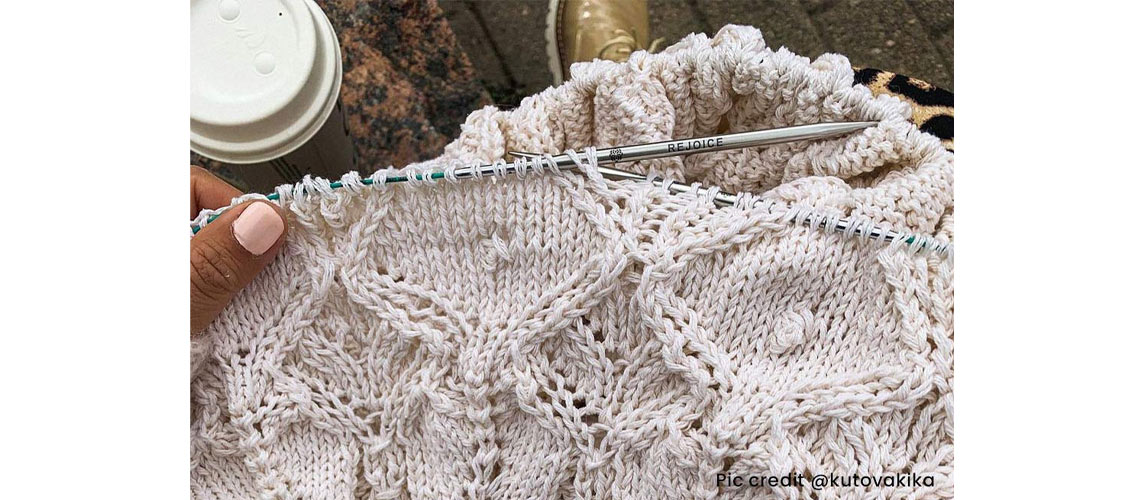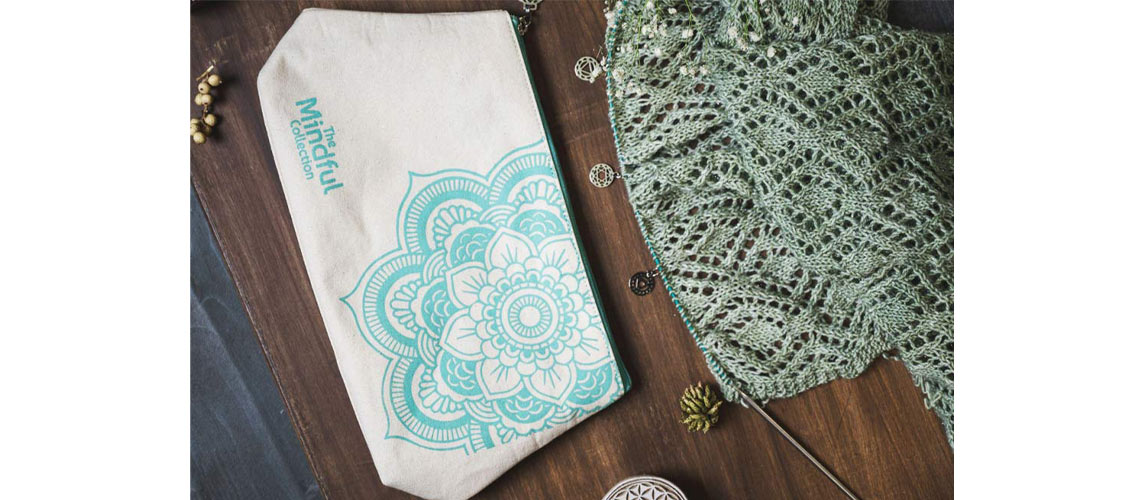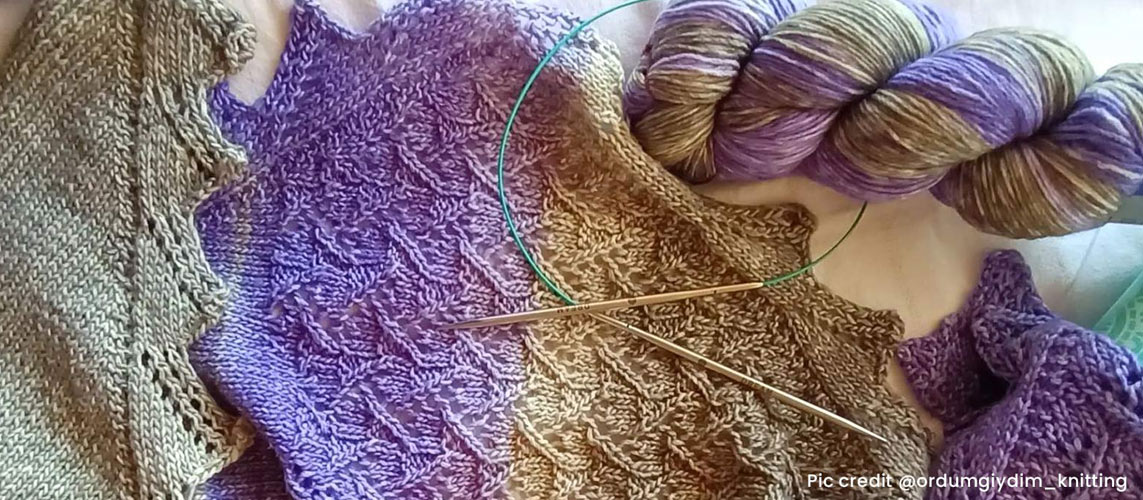Lace knitting is an art – when done well, it turns the knitter into a fibre artist. For new knitters, the result looks breathtaking but is also puzzling and mysterious. It is not as complicated as it looks but can easily be made with appropriate knitting needles. Lace knitting patterns comprise ethereal patterns of leaves, flowers, and abstract designs. It is one of the most beautiful forms of knitting with patterns ranging from beginner to advanced, for projects from sweaters to scarves, hats to gloves and pretty much anything.
Beginner knitters can try lace knitting as soon as they’ve added gained the skills of making knit and purl stitches. The other lace knitting techniques can be easily learned. To help knitters get started with lace knitting, we’ll guide you through the best knitting needles for lace, lace yarn and stitches & techniques. For your beginner projects, it is best to try back-and-forth knitting and simple patterns before moving to knit in the round.
So, let’s get started.
Knitting Needles for Lace Patterns
Lace patterns do not require special knitting needles. You can knit with any needle of size 2mm to 12mm, preferably made from stainless steel, with a pointy tip and appropriate yarn. Lace knitting also requires techniques different from the usual garter and stocking stitches. Whether you use single points, double points or even circular knitting needles doesn’t matter – either will work when worked with the right size. If you are planning your own design, it is recommended that you go for knitting needles a size bigger than mentioned on the yarn label, so that you have the desired lace effect.
Yarn for Knitting Lace
Every knitter loves their yarn. For lace knitting, you can knit with any yarn weight or color, but it is always recommended to use high-quality yarn. The general theme of lace knitting is lightweight yarn and needle sizes bigger than mentioned on the yarn label. Lightweight merino is ideal for beautiful and striking lace patterns while cashmere is the ultimate in luxury, as is silk and best reserved once you’ve mastered the basics.
Choosing Knitting Accessories
Lace knitting requires extra assistance in the form of knitting accessories. Make sure to have a complete range of stitch markers. Locking, split, and ring markers are of great help. Our guide on how to use stitch markers will assist you with the needed information. Given the delicate nature of lace yarns, mistakes can often turn into unrepairable disasters, so row counters are a must-have. Even when you are done with your project, blocking tools will help you show off the pattern. The darning needle will help weave in yarn ends as invisibly as possible.
Now getting back to lace knitting, let’s look at the stitches and techniques you need to learn.
Lace Knitting Stitches and Techniques

Like all knitting patterns, lace requires knit and purl stitches. You can make lace with the usual garter (all rows of knit stitches) and stocking stitch (alternate rows of knit and purl stitches). Our guide on knitting stocking stitches on circular needles will help you. There are a few additional techniques to make the artful holes that give definition to lace knits. Knitting techniques such as increases and decreases with your favorite pair of lace knitting needles are the key to successful ethereal lace patterns.
1. The yo knitting stitch
The yarn over (YO) technique creates an extra loop of yarn around your needle, which you work into on the repeat row or round as if it were just another stitch. It’s an increased technique as you create a new stitch that wasn’t there before and adds to your stitch count. Since it’s a new stitch with no pre-existing stitch under it, YO creates a hole in the fabric.
There are different terms used for yarnovers in lace patterns. There is ‘yarn forward’ (yf) or ‘yarn round needle’ (yrn), but they mean the same thing. Both describe the different ways of creating a yarn over and are well worth practicing.
2. K2tog yo
The ‘k2tog, yo’ or ‘yo k2tog’ means to knit two together. It is a simple knitting decrease that is often seen in lace knitting patterns. It is generally positioned next to the yarn over to keep the stitch count constant. This won’t help with any shaping and is perfect for a shawl or scarf, knitted flat.
The k2tog decrease looks almost invisible next to the yarn over and forms a small and stable hole in the knitting.
3. Ssk
Ssk means to slip, slip, knit. It is a mirror image of k2tog. The name is counter-intuitive and is not as it seems. The technique is more than just slipping and knitting. It neatly decreases one stitch within the actual pattern creating a lovely visual effect. There are many ways to do so. Make sure to try them all as you may not know which would work for you the best.
4. Sl1, k2tog, psso
The Sl1, k2tog, psso means to slip 1 stitch, knit the next 2 together, and pass the slipped stitch over the stitches that were knitted together. It is a “double” left-leaning decrease technique often used in knitting lace patterns.
The lace knitting techniques may look complicated but they are easy. Once you start using them in your patterns, you’ll soon see that they become second nature with some practice! To make lace patterns easy, add a lifeline in a contrasting colour to your projects. These lifelines are threaded through the stitches and not knitted as part of a row, making them very easy to see and remove after your project is completed.
Also, once you’ve knitted your pattern, it may not seem like the one in the design, the reason being it has not been blocked. Blocking is a very important part of lace knitting patterns. With proper blocking tools and our guide on how to block your knitting you can give a properly finished effect to your projects.

The Mindful Collection offers stainless steel knitting needles that are ideal for fine work such as lace patterns. The pointy tips are precise for the job and smooth. The needles work well with all yarns such as wool, cotton, mohair and even hand-dyed yarn fibres. For lace knitting and for that matter any knitting project, it is wise to invest in an interchangeable needle set. One set provides multiple needle sizes as well cable lengths that offer versatility to change the needle size or to increase or decrease the needle length to accommodate the changing widths of your project. Also, the interchangeable circular needles of the range come with a lifeline hole to thread in a lifeline to assist you with knitting projects, especially lace patterns.
With the beginner's guide to lace knitting, you can start with your project. Lace knitting is fun if you are equipped with suitable knitting needles, so get started with the Mindful Collection.












